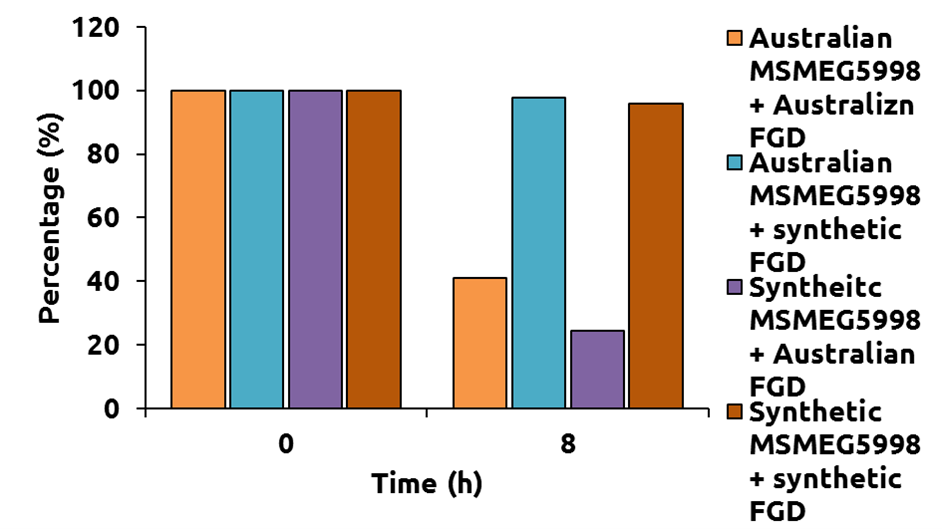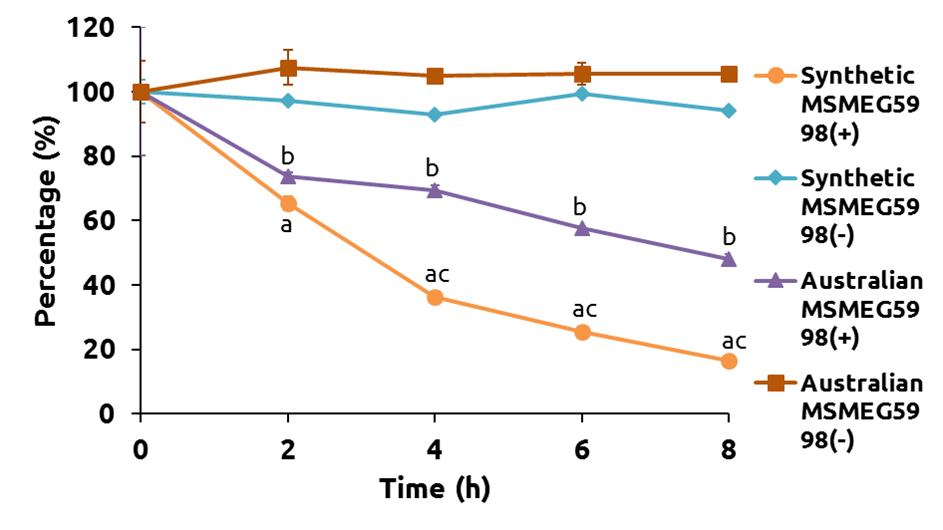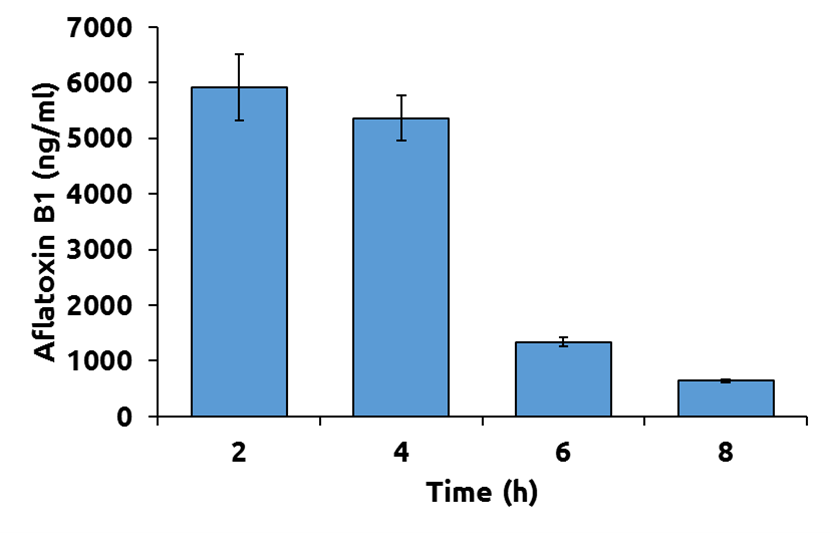Difference between revisions of "Part:BBa K2382006"
Herlohuang (Talk | contribs) |
Herlohuang (Talk | contribs) |
||
| Line 4: | Line 4: | ||
| − | + | <!-- Add more about the biology of this part here | |
| + | |||
| + | |||
| + | <!-- --> | ||
| + | <span class='h3bb'>Sequence and Features</span> | ||
<partinfo>BBa_K2382006 SequenceAndFeatures</partinfo> | <partinfo>BBa_K2382006 SequenceAndFeatures</partinfo> | ||
| Line 10: | Line 14: | ||
<!-- Uncomment this to enable Functional Parameter display | <!-- Uncomment this to enable Functional Parameter display | ||
===Functional Parameters=== | ===Functional Parameters=== | ||
| − | <partinfo> | + | <partinfo>BBa_K2382006 parameters</partinfo> |
<!-- --> | <!-- --> | ||
| − | |||
===Usage and Biology=== | ===Usage and Biology=== | ||
| − | |||
| − | |||
| − | + | This is an enzyme that could degrade aflatoxin with the aid of coenzyme F420. It belongs to the | |
| − | + | F420H2-dependent reductases family from Mycobacterium Smegmatis. | |
| − | Two of | + | |
| − | the standard backbone pSB1C3. First, we transformed all of our plasmids into E. coli BL21 (DE3) | + | <html> |
| − | strain to express our proteins. Then IPTG was used to induce the expression system | + | </p> |
| − | since all plasmids in our project had T7 promoter. We sonicated E. coli and did 9500 rpm | + | </html> |
| − | and 13000 rpm centrifugation to remove the cell pellet and obtain the supernatant. To | + | __TOC__ |
| − | confirm the suitable concentration of cell supernatant, we | + | |
| − | cell supernatant (the 13000 Su group). | + | |
| + | ==Characterization of the Thioredoxin-MSMEG_5998 fusion protein== | ||
| + | ===Expression results === | ||
| + | ====IPTG induction==== | ||
| + | <div style="text-align:justify;"> | ||
| + | Two of the composite parts (BBa_K2382005 and BBa_K2382006) were synthesized by Allbio Life Co., Ltd and put into the standard backbone pSB1C3. First, we transformed all of our plasmids, including two plasmids from Australia and two of our own composition parts into E. coli BL21 (DE3) strain to express our proteins. Then IPTG was used to induce the expression system since all plasmids in our project had T7 promoter. We sonicated E. coli and did 9500 rpm and 13000 rpm centrifugation to remove the cell pellet and obtain the supernatant. To confirm the suitable concentration of cell supernatant, we did SDS-PAGE electrophoresis and coomassie brilliant blue staining. The results is demonstrated in the Fig. 1B. After centrifuging two times, we could find a high percentage of proteins in the cell supernatant (the 13000 Su group) | ||
| + | |||
| + | |||
| + | |||
| + | [[File:Fig 1B (CSSMU NCHU).png|350px|thumb|left|Figure 1B: Cell lysates were analyzed by SDS-PAGE and coomassie brilliant blue staining. 9500 T meant the initial sample obtained after sonication; 9500 P and 13000 T meant the pellet and the supernatant gotten after 9500 rpm for 20 min; 13000 P and 13000 Su meant the pellet and the supernatant obtained after 13000 rpm for 20 min. (A)(B) Samples contained Australian and synthetic MSMEG5998.]] | ||
| + | |||
| + | <br style="clear: both" /> | ||
| + | |||
| + | |||
| + | ====Protein purification, and dialysis==== | ||
| + | After extracting the cell lysates, we used nickel-resin column to purify our target proteins from the cell lysates because all of our proteins were tagged with 6 histidines at their C-terminal ends. After protein purification, protein dialysis with diaysis buffer containing 150 mM NaCl, 20 mM Tris-HCl (pH=7.5), and 20% glycerol to remove imidazole in our purified proteins, we did SDS-PAGE gel electrophoresis to ensure our target proteins were successfully purified (Fig. 2A ). The molecular weights of these proteins are listed in the Table 1. The standard BSA proteins were used to quantify the concentration of target proteins. | ||
| + | |||
| + | <table cellpadding="2" border="1px" cellspacing="0" align="center" width="70%"> | ||
| + | <caption><p align="justify"><b>Table 1: Two expressed recombinant proteins and their molecular weights are listed.</b></p></caption> | ||
| + | <td><b>Proteins</b></td> | ||
| + | <td>Molecular weight</td> | ||
| + | |||
| + | <tr> | ||
| + | <td><b>Synthetic MSMEG5998</b></td> | ||
| + | <td>32.4 kDa</td> | ||
| + | </tr> | ||
| + | <tr> | ||
| + | <td><b>Synthetic FGD</b></td> | ||
| + | <td>51.5 kDa</td> | ||
| + | </tr> | ||
| + | </table> | ||
| + | |||
| + | [[File:Fig 2B.png|350px|thumb|left|'''Figure 2B''': Concentration of proteins was quantified by SDS-PAGE and standard BSA samples with 0.16, 0.31, 0.63, 1.25, 2.5, 5, 10 mg/ml. (B) Two recombinant proteins expressed by the plasmids from DNA synthesis.]] | ||
| + | <br style="clear: both" /> | ||
| + | |||
| + | ====Protein solubility analysis==== | ||
| + | To know whether the solubility of our two enzymes (MSMEG_5998 and FGD <partinfo>BBa_K2382002</partinfo>) increased after fusing enzymes with thioredoxin, we dissolved all cell lysates which containing pellet and supernatant and did western blot to detect the content of our target proteins. All proteins were detected by anti-6x His Tag antibody because all of them contained a 6-histidines tail when bacteria expressed them. In Fig. 3, we could find there was good expression of both Australian and synthetic MSMEG5998 in the “13000 Su” group when compared with the “13000 P” group. This result meant that most proteins were dissolved in the supernatant while few proteins deposited in the cell pellet after 13000-rpm centrifugation. However, we could not observe good solubility in both Australian and synthetic FGD because there were little or no difference between the “13000 Su” group and the “13000 P” group. | ||
| + | |||
| + | [[File:Fig 3.png|350px|thumb|left|'''Figure 3''': Cell lysates in the process of two times centrifuge were analyzed by western blot. The abbreviations of five groups were the same as Fig. 1. ]] | ||
| + | <br style="clear: both" /> | ||
| + | |||
| + | ==Enzyme Function Results== | ||
| + | ===Enzyme Activity Assay=== | ||
| + | The conditions of reaction to degrade aflatoxin by MSMEG5998 were modified from Taylor’s study[6]. All concentrations of reactants are listed in '''Table 2''' and 32 μM aflatoxin was used. We first mixed all reactants in eppendorfs and then put them at 22°C. | ||
| + | |||
| + | |||
| + | [[File:Fig 7A (CSMU NCHU).png |450px|thumb|left|'''Figure 7A''': MSMEG5998 could significantly degrade aflatoxin at time manner in vitro. (A) Direct 365 nm absorbance were detected after mixing Australian/synthetic MSMEG5998 and Australian/synthetic FGD and other reactants at 0th and 8th hour in the environment of pH=7.5 and 22℃.]] | ||
| + | |||
| + | |||
| + | In '''Fig. 7A''', we compared two proteins, MSMEG5998 and F420-dependent glucose-6-phosphate dehydrogenase (FGD) expressed from Taylor’s vectors (from Australia) and from our synthetic vectors. We found that both the Australian and synthetic MSMEG5998 have great activity and degraded aflatoxin B1 by more than 60%. The effect of the synthetic one may be better than the Australian one but there were no statistic significance. | ||
| + | <br style="clear: both" /> | ||
| + | |||
| + | <table cellpadding="2" border="1px" cellspacing="0" align="center" width="70%"> | ||
| + | <caption><p align="justify"><b>Table 2: The substance concentration of the aflatoxin-degradation reaction. For convenience sake, we called G6P, F420, FGD, and tris buffer as the reactants.</b></p></caption> | ||
| + | <td><b>Name</b></td> | ||
| + | <td>Concentration</td> | ||
| + | |||
| + | <tr> | ||
| + | <td><b>Aflatoxin B1</b></td> | ||
| + | <td>32 or 10 μM</td> | ||
| + | </tr> | ||
| + | <tr> | ||
| + | <td><b>MSMEG5998</b></td> | ||
| + | <td>0.1 μM</td> | ||
| + | </tr> | ||
| + | <table cellpadding="1" border="2px" cellspacing="0" align="center" width="70%"> | ||
| + | <td><b>Reactants</b></td> | ||
| + | <table cellpadding="2" border="1px" cellspacing="0" align="center" width="70%"> | ||
| + | <td><b>Glucose-6-phosphate (G6P)</b></td> | ||
| + | <td>2.5 mM</td> | ||
| + | |||
| + | <tr> | ||
| + | <td><b>F420</b></td> | ||
| + | <td>5 μM</td> | ||
| + | </tr> | ||
| + | <tr> | ||
| + | <td><b>F420-dependent glucose-6-phosphate dehydrogenase (FGD)</b></td> | ||
| + | <td>0.225 μM</td> | ||
| + | </tr> | ||
| + | <tr> | ||
| + | <td><b>Tris-HCl (pH=7.5)</b></td> | ||
| + | <td>25 mM</td> | ||
| + | </tr> | ||
| + | <tr> | ||
| + | </table> | ||
| + | |||
| + | |||
| + | |||
| + | However, only Australian FGD has activity to reduce F420 into F420H2 and help the reaction. This finding corresponds with our dry lab results. Therefore, we used Australian and synthetic MSMEG5998 and Australian FGD to do the same experiment again to figure out whether the degradation percentage was dependent of time and whether the main reason of degradation was MSMEG5998. | ||
| + | </p> | ||
| + | <br style="clear: both" /> | ||
| + | |||
| + | [[File:Fig 7B (CSMU NCHU).png |450px|thumb|left|'''Figure 7B''': MSMEG5998 could significantly degrade aflatoxin at time manner in vitro. (B) The same way as (A) but Australian/synthetic MSMEG5998 and Australian FGD were used and the reaction were detected at 0th, 2nd, 4th, 6th, and 8th hour. a, p < 0.001 compared to the 0th hour of the synthetic MSMEG5998(+) group; b, p < 0.001 compared to the 0th hour of the Australian MSMEG5998(+) group; c, p < 0.001 compared to the same time of the Australian MSMEG5998(+) group.]] | ||
| + | [[File:Fig 7C( CSMU NCHU ).png |450px|thumb|left|'''Figure 7C''': MSMEG5998 could significantly degrade aflatoxin at time manner in vitro. (C) The same way as (B) but the degradation percentage were detected by ELISA. Because the initial concentration of aflatoxin (10000 ng/ml) was too high to be detected by the ELISA, we didn’t demonstrate the initial data.]] | ||
| + | <p align="justify"> | ||
| + | |||
| + | |||
| + | The results were detected by direct 365 nm absorbance ('''Fig. 7B''') and by ELISA ('''Fig. 7C'''). We found out that the degradation percentage was time-dependent. The synthetic MSMEG5998 had better activity than Australian MSMEG5998. The former was able to degrade 83% aflatoxin after 8 h while the latter could only degrade 52% aflatoxin. | ||
| + | |||
| + | |||
| + | <br style="clear: both" /> | ||
| − | |||
| − | |||
| − | |||
| − | |||
| − | |||
| − | |||
| − | |||
| − | |||
| − | |||
| − | |||
| − | |||
| − | |||
| − | |||
| − | |||
| − | |||
| − | |||
| − | |||
| − | |||
| − | |||
| − | |||
| − | |||
| − | |||
===References=== | ===References=== | ||
Revision as of 17:31, 31 October 2017
T7 promoter + Thioredoxin-MSMEG_5998 fusion protein
Sequence and Features
- 10COMPATIBLE WITH RFC[10]
- 12COMPATIBLE WITH RFC[12]
- 21INCOMPATIBLE WITH RFC[21]Illegal BamHI site found at 456
Illegal XhoI site found at 462 - 23COMPATIBLE WITH RFC[23]
- 25INCOMPATIBLE WITH RFC[25]Illegal AgeI site found at 901
- 1000COMPATIBLE WITH RFC[1000]
Usage and Biology
This is an enzyme that could degrade aflatoxin with the aid of coenzyme F420. It belongs to the F420H2-dependent reductases family from Mycobacterium Smegmatis.
Contents
Characterization of the Thioredoxin-MSMEG_5998 fusion protein
Expression results
IPTG induction
Two of the composite parts (BBa_K2382005 and BBa_K2382006) were synthesized by Allbio Life Co., Ltd and put into the standard backbone pSB1C3. First, we transformed all of our plasmids, including two plasmids from Australia and two of our own composition parts into E. coli BL21 (DE3) strain to express our proteins. Then IPTG was used to induce the expression system since all plasmids in our project had T7 promoter. We sonicated E. coli and did 9500 rpm and 13000 rpm centrifugation to remove the cell pellet and obtain the supernatant. To confirm the suitable concentration of cell supernatant, we did SDS-PAGE electrophoresis and coomassie brilliant blue staining. The results is demonstrated in the Fig. 1B. After centrifuging two times, we could find a high percentage of proteins in the cell supernatant (the 13000 Su group)

Protein purification, and dialysis
After extracting the cell lysates, we used nickel-resin column to purify our target proteins from the cell lysates because all of our proteins were tagged with 6 histidines at their C-terminal ends. After protein purification, protein dialysis with diaysis buffer containing 150 mM NaCl, 20 mM Tris-HCl (pH=7.5), and 20% glycerol to remove imidazole in our purified proteins, we did SDS-PAGE gel electrophoresis to ensure our target proteins were successfully purified (Fig. 2A ). The molecular weights of these proteins are listed in the Table 1. The standard BSA proteins were used to quantify the concentration of target proteins.
| Proteins | Molecular weight |
| Synthetic MSMEG5998 | 32.4 kDa |
| Synthetic FGD | 51.5 kDa |
Protein solubility analysis
To know whether the solubility of our two enzymes (MSMEG_5998 and FGD BBa_K2382002) increased after fusing enzymes with thioredoxin, we dissolved all cell lysates which containing pellet and supernatant and did western blot to detect the content of our target proteins. All proteins were detected by anti-6x His Tag antibody because all of them contained a 6-histidines tail when bacteria expressed them. In Fig. 3, we could find there was good expression of both Australian and synthetic MSMEG5998 in the “13000 Su” group when compared with the “13000 P” group. This result meant that most proteins were dissolved in the supernatant while few proteins deposited in the cell pellet after 13000-rpm centrifugation. However, we could not observe good solubility in both Australian and synthetic FGD because there were little or no difference between the “13000 Su” group and the “13000 P” group.
Enzyme Function Results
Enzyme Activity Assay
The conditions of reaction to degrade aflatoxin by MSMEG5998 were modified from Taylor’s study[6]. All concentrations of reactants are listed in Table 2 and 32 μM aflatoxin was used. We first mixed all reactants in eppendorfs and then put them at 22°C.
In Fig. 7A, we compared two proteins, MSMEG5998 and F420-dependent glucose-6-phosphate dehydrogenase (FGD) expressed from Taylor’s vectors (from Australia) and from our synthetic vectors. We found that both the Australian and synthetic MSMEG5998 have great activity and degraded aflatoxin B1 by more than 60%. The effect of the synthetic one may be better than the Australian one but there were no statistic significance.





